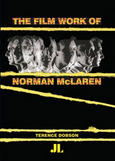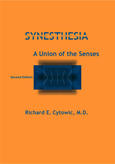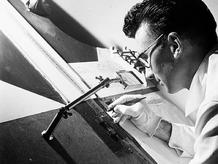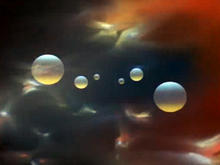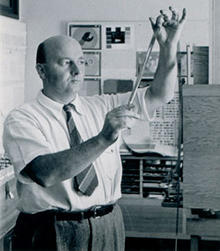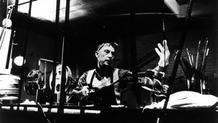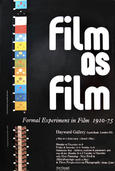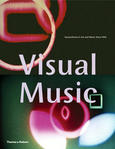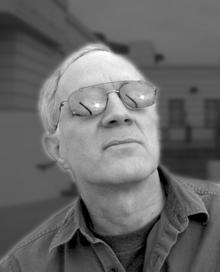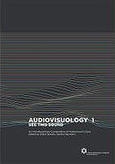Synchromie
(1971)by Norman McLaren's most synesthetic work, which uses the photographed pitch cards to create the music. McLaren was most certainly influenced by Rudolph Pfenninger's Graphical (Drawn) Sound technique from around 1929.
To make this film Norman McLaren developed novel optical techniques to compose the sound track. It is synchronization of image and sound in the truest sense of the word, similar to Oskar Fischinger's Ornament Sound.
"I can discern 4 influences. First of all Oskar Fischinger, with his Hungarian Dance No. 5, because this film gave me the courage of my convictions. I wanted to make abstract films - not necessarily abstract films - but to compose abstract images based on music, and at that time I did not know how to go about it. At home I constructed coloured lights and moved them by hand over paper. But when I saw Oskar Fischinger's, I told myself the solution was to make abstract films. Then there was Émile Cohl. I saw Drama Among The Puppets (1908), and was struck by the purity, the simplicity of line, and the wonderful metamorphosis. I am not forgetting Alexandre Alexeieff and his Night On A Bare Mountain (1933). What gripped me was the fertile imagination, not so much technique as the creative imagination, the bold metamorphosis and the surrealist thinking. For surrealism had made a great impression on me. Finally Len Lye and his techniques of drawing directly onto the film. That is all. But I add two general influences: Pudovkin and Eisenstein." (Norman McLaren)
Source: EM Arts
Around 1950, Evelyn Lambart and I worked out a method of shooting soundtrack optically on film, without using a microphone or regular sound system, but with the use of an animation camera. We called it animated sound, because it was shot frame by frame, onto the soundtrack area at the edge of the picture.
For pitch control we used a set of 72 cards, each having stripes or striations, and each representing a semi-tone in a chromatic scale of six octaves. The more stripes the higher the note, the less stripes the deeper the note.
Our first set of the cards (with which the music for Neighbours was made) had soft-edge undulating stripes, corresponding roughly sine-wave sound. A later set of cards had simple hard-edge black-and-white stripes, corresponding acoustically to square-wave sound. It is with the square-wave cards that I shot the music for Synchromy.
The volume was controlled by varying the width of the soundtrack. A moveable shutter, controlled this width. If the shutter was almost closed, the extremely narrow band of striations would give a pianissimo note. If the shutter was wide open, the broad band of stripes would give fortissimo. All intermediate degrees of volume were possible by regulating the position of the shutter, which was calibrated in decibels.
In Synchromy the music was composed first, and filmed by the above method. It started with a single musical part, later to be joined by another, and finally by a third (mid pitch, treble and bass).
These three parts were shot on separate strips of film, which were rerecorded and finally mixed in the normal manner onto magnetic tape and thence to standard optical track for release prints.
Source: "Technical Notes on Synchromy (1971)" (PDF) by Norman McLaren
